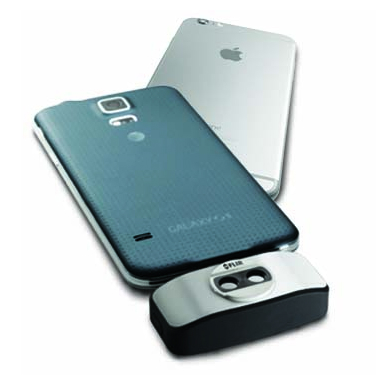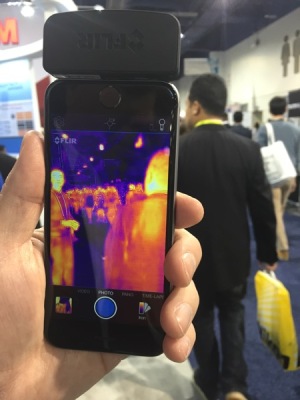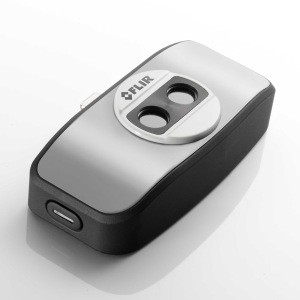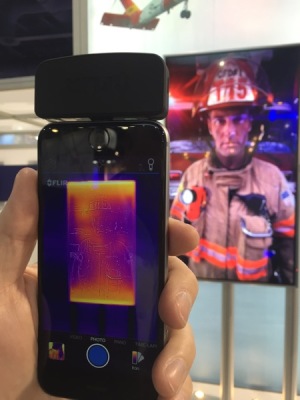 More big news from FLIR this week at CES. The FLIR ONE thermal camera that made headlines last year is considerably improved, and is now compatible with both iOS and Android. FLIR has also given the device a new form factor, with the camera now attaching at the charging/data port. This will open the door to compatibility with a multitude of phones and tablets, rather than the original iPhone 5-only design. Price has yet to be determined, but we expect it will land somewhere near the $349 cost of the original. The updated FLIR ONE for iOS and FLIR ONE for Android are expected to be available sometime in mid 2015.
More big news from FLIR this week at CES. The FLIR ONE thermal camera that made headlines last year is considerably improved, and is now compatible with both iOS and Android. FLIR has also given the device a new form factor, with the camera now attaching at the charging/data port. This will open the door to compatibility with a multitude of phones and tablets, rather than the original iPhone 5-only design. Price has yet to be determined, but we expect it will land somewhere near the $349 cost of the original. The updated FLIR ONE for iOS and FLIR ONE for Android are expected to be available sometime in mid 2015.
Imaging
Like the first generation model, the new FLIR ONE includes both a thermal camera and a visible light camera mounted side by side. The thermal imaging performance of the tiny Lepton core is “improved” says FLIR, leaving the specifics for a later date. Sensitivity of the core remains the same, still a good 0.10 °C. The updated FLIR ONE has a broader temperature imaging range, now reading everything from -4 to 248 °F (-20 to 120 °C), for an increase of 36 °F. Objects are still fuzzy to be sure, but less so than before, and with better detail and gradients.
MSX
The visible light camera is integral to the overall image quality of the FLIR ONE. The infrared is clearly what you’re after when buying a thermal camera, but the built in visible camera adds a level of definition that makes the image much more intelligible. Through a process called MSX, the FLIR ONE gathers data about object edges, writing, and patterns from the visible image and etches these into the thermal image. All thermal data and coloring is retained, with subtle grayscale lines outlining objects and words as we would normally see them.
Temperature Measurement
FLIR doesn’t tout the FLIR ONE as a measurement tool, pointing consumers instead to their more traditional imagers like the FLIR E4. Even so, the second generation FLIR ONE has made gains in this department. The new model incorporates an automatic shutter function to more reliably correct for the temperature drift of the thermal sensor. Gone is the switch on the front that had to be frequently depressed to keep the camera in calibration. Temperature measurement is accomplished through a center spotmeter that can be toggled on and off as needed, with both Fahrenheit and Celsius scales available. Many more measurement options are available if users import their images to the free FLIR Tools software.
New Mobile App
With the release of the new model later this year FLIR will also be updating the FLIR ONE app that controls the camera. The new version will combine the several specialized apps into one platform. The app captures photos (jpg), video (mov), panoramic images, and can create time lapse movies. Color palettes available include iron, grayscale, rainbow, high contrast, and arctic. Captured media can be stored within the app, or stored to the camera roll of the phone or tablet for easy transfer and sharing. Images are output in a standard VGA 640 x 480 size.
Using the FLIR ONE
The new FLIR ONE attaches to a phone or tablet through a lightning (iOS) or micro USB port (Android). This serves as both the means of data transfer as well as a physical support mechanism. The FLIR ONE weighs in at under 3 ounces and did not feel like it put undue stress on the iPhone we were using. Holding it gives you the sense that you wouldn’t want to drop the phone-plus-camera combo for fear of damage. But who doesn’t already feel this way about the phone alone? If such fears have led you to put a case on your device, the case may not be compatible with the FLIR ONE. Some thin bumper cases will work fine, but anything thicker will require removing the case.
The change in how the FLIR ONE connects to a device will mean that those using Apple products will now have a choice in how to connect the thermal camera–facing toward or away from the user. While having the camera face you will be helpful for the occasional thermal selfie, we found it most natural to have the camera face away, much as it would on any smartphone. Because the on screen image will orient to however the iPhone is held, most users at CES had the FLIR ONE “on top”, with both the phone and imager upside down. While it might sound odd, it looks and feels quite natural, and keeps unwelcome fingers from your image. As before, the FLIR ONE includes a rechargeable battery of its own, and will neither charge nor draw power from its parent device.
Final Thoughts
Ultimately the FLIR ONE has evolved into a lighter, more portable, and more universal device. Rather than a case tied to a specific phone, it has become an accessory that can be used on a variety of products. The thermal image is improved, and will likely continue to improve incrementally, as it has done in visible spectrum cameras. This is still not a camera that professionals will want to use to evaluate energy issues in buildings, or issues of electrical and mechanical failure. Yet the cutting edge FLIR ONE nonetheless remains a marker of what the future of infrared may hold. And until then it still makes for great fun.
Have thoughts or questions about the new FLIR ONE? We welcome your comments below, or you can drop us a line at [email protected]



Pingback: Hands On Review: FLIR ONE iPhone Infrared Camera | Ivy Tools Blog
Pingback: Live Video from FLIR ONE iPhone Thermal Camera | Ivy Tools Blog
Pingback: Second Generation Flir One - InterNACHI Inspection Forum
Pingback: Full Review: FLIR Scout TK Handheld Thermal Camera | Ivy Tools Blog